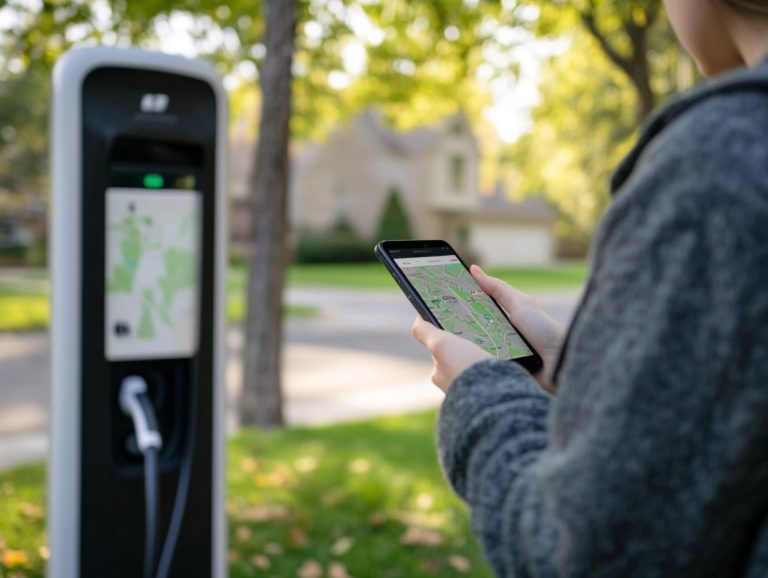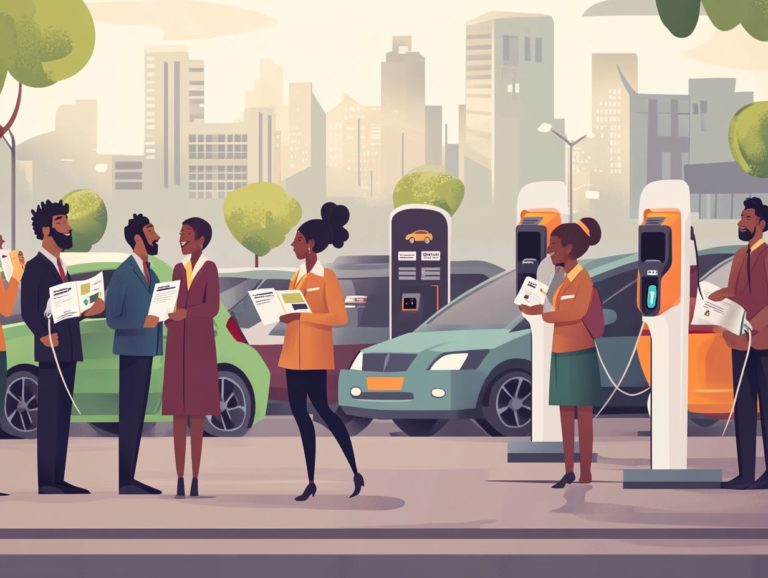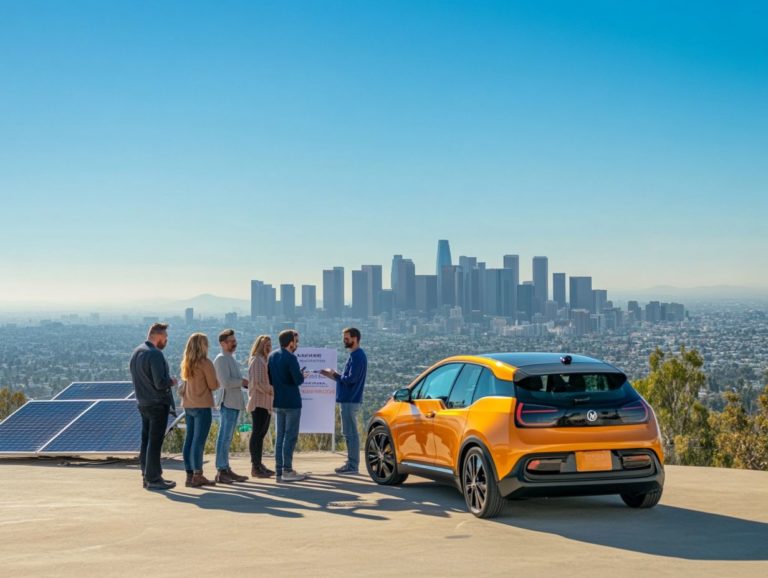how to access ev incentives as a new buyer
As electric vehicles (EVs) continue to rise in popularity, grasping the available incentives can greatly diminish the cost of your journey toward sustainability.
This comprehensive breakdown explores the many types of EV incentives, including tax credits, rebates, and grants, while also clarifying eligibility requirements such as income limits and vehicle specifications.
You ll find clear guidance on the application process and valuable tips to maximize your savings.
Whether you re a first-time buyer or contemplating an upgrade, this guide is designed to help you expertly navigate the landscape of EV incentives.
Contents
- Key Takeaways:
- Understanding Electric Vehicle Incentives
- Types of EV Incentives
- Eligibility Requirements for EV Incentives
- How to Access EV Incentives
- Steps to Apply for Incentives
- Additional Resources for Finding Incentives
- Maximizing Your Savings with EV Incentives
- Tips for Getting the Most Out of Incentives
- Frequently Asked Questions
Key Takeaways:

2. Check eligibility requirements: Make sure you meet the income and vehicle requirements for incentives before applying to ensure you can take advantage of the savings.
3. Maximize your savings: Use additional resources and follow application steps carefully to save the most money through EV incentives.
Understanding Electric Vehicle Incentives
Understanding electric vehicle incentives is crucial when transitioning to cleaner transportation. This includes battery electric vehicles (BEVs), plug-in hybrid electric vehicles (PHEVs), or fuel cell vehicles (FCVs).
These incentives, influenced by regulations like the Inflation Reduction Act, offer financial relief through avenues such as tax credits and rebates, bolstered by federal funding and IRS guidelines found in resources like Publication 5866.
As the market for clean vehicles expands, grasping these incentives gives you the power to make informed decisions while playing a part in a sustainable, e-mobility future.
Types of EV Incentives
You ll find a variety of incentives designed to promote the adoption of electric vehicles (EVs), such as tax credits, rebates, and grants.
Each of these incentives is thoughtfully designed to cater to the unique needs of individual consumers as well as commercial clean vehicle users.
Tax Credits
Tax credits for electric vehicles are designed to help you by offering significant reductions on your federal tax liabilities, which can substantially lower the overall cost of purchasing a clean vehicle.
These credits are determined by various factors, including the vehicle’s manufacturer s suggested retail price (the price suggested by the vehicle maker) and your total income after certain adjustments, known as modified adjusted gross income (MAGI). For example, certain credits may have caps based on the vehicle’s MSRP, ensuring that more affordable models receive fair support.
The IRS guidelines outline income limits that may affect your eligibility; for instance, if your MAGI exceeds a specified threshold, you might find your credits gradually phased out.
This exciting framework encourages eco-friendly vehicle adoption while ensuring that those who need help the most get it!
For detailed regulations and examples, you should consult IRS Publication 970.
Rebates
Rebate programs provide you with immediate financial relief when purchasing electric vehicles by offering cash back after the sale. This can be especially advantageous if you re investing in commercial vehicles or e-bikes.
These programs differ by state and can significantly lower your overall cost of ownership. For example, in Oregon, the Clean Vehicle program aims to enhance access to electric and hybrid vehicles, offering substantial rebates that complement existing federal tax credits.
This synergy between state and federal incentives allows you to maximize your savings, making the transition to greener transportation not only eco-friendly but also financially savvy.
Other states are following suit with similar initiatives to support clean energy choices, encouraging a broader adoption of electric alternatives and paving the way for a more sustainable future.
Grants

Grants are available for consumers and businesses to establish charging infrastructure and acquire commercial clean vehicles. These efforts pave the way for a more comprehensive shift to electric mobility.
These financial incentives, such as the Federal Transit Administration s Low or No Emission Vehicle Program and the U.S. Department of Energy s Clean Cities Program, support projects aimed at reducing dependence on fossil fuels.
Eligibility typically depends on factors like project location and the annual number of vehicles in operation. It’s essential to carefully review the criteria before applying.
By promoting the adoption of electric vans and trucks, these initiatives significantly lower greenhouse gas emissions and advance sustainable transportation solutions within communities.
Other Incentives
In addition to tax credits and rebates, there are other incentives aimed at promoting electric vehicle adoption, including support for charging infrastructure and initiatives that advance e-mobility.
Several states are rolling out programs to strengthen their charging networks. Local governments increasingly recognize the critical role that accessible charging stations play in fostering clean transportation.
Partnerships between municipalities and private companies are creating new opportunities to boost the availability of charging points. Federal funding is directed toward projects aimed at installing more chargers in underserved areas, ensuring that the transition to electric vehicles is swift and equitable.
These exciting partnerships are crucial for building a robust infrastructure that encourages you to embrace cleaner, sustainable mobility solutions.
Eligibility Requirements for EV Incentives
Eligibility requirements for electric vehicle incentives can vary widely. Factors include income limits, vehicle specifications, and battery capacity.
Understand these criteria clearly before submitting your application to maximize your benefits!
Income Limits
Income limits are key to determining your eligibility for various tax credits and incentives, especially the nonrefundable tax credits offered by the IRS. These limits are closely tied to your total income after certain adjustments.
For example, credits such as the Premium Tax Credit and the Child Tax Credit come with specific income thresholds that vary based on your filing status and number of dependents. Understanding these thresholds is vital; exceeding them can significantly affect your ability to claim valuable benefits.
This highlights the necessity of accurate financial reporting and thoughtful tax planning to ensure you re making the most of your eligible credits.
Vehicle Requirements
To qualify for electric vehicle incentives, you must ensure that your vehicle meets specific requirements related to battery capacity and weight rating.
It’s not just about having the right battery; vehicles seeking these incentives often need to demonstrate a minimum electric range and comply with particular rules that limit harmful gases that vehicles can emit.
Many programs are designed to promote clean energy by mandating that vehicles produce zero tailpipe emissions.
Your vehicle’s design is crucial for eligibility; it must meet specific weight limits based on its type and size.
By fulfilling these criteria, manufacturers contribute to a more sustainable future while reaping substantial financial rewards.
How to Access EV Incentives

Accessing electric vehicle incentives requires a smart approach. Start by identifying eligible vehicles at dealerships and then consider navigating the world of EV financial incentives to submit applications for tax credits or rebates.
Each step is crucial to ensuring you maximize the benefits available to you.
Are you ready to shift towards cleaner transport? Take the first step today!
Steps to Apply for Incentives
Applying for electric vehicle (EV) incentives may seem daunting, but it can be straightforward when you learn how to find the best EV incentives in 2024 and break it down into manageable steps.
Start by gathering necessary documentation and familiarizing yourself with the guidelines established by the IRS, as detailed in Publication 5866. This preparation ensures you meet all eligibility criteria.
Your first task is to compile essential documents, which include:
- Proof of vehicle purchase
- The Vehicle Identification Number (VIN)
- Any relevant prior tax forms
Check local regulations and deadlines, as they can vary by state and the specific type of incentive. This will help you avoid missing out on valuable benefits.
Understanding IRS guidelines is crucial, as they list the specific requirements for the tax credits available to EV owners. Adopting a meticulous approach is vital for a successful application process.
Additional Resources for Finding Incentives
Finding electric vehicle incentives can be exciting when you tap into a variety of resources, including local dealerships, government websites, and platforms that explain how to best utilize EV incentives in 2024 dedicated to EV solutions.
Visit specific government sites like the Department of Energy or your state s energy office for a wealth of information on available rebates and tax credits.
Local dealerships may also have programs providing added savings on your electric vehicle purchase, including information on how to qualify for local EV rebates, making that new ride even more enticing.
Engage with community forums or local EV clubs for valuable insights and firsthand experiences regarding incentives. This simplifies the complex landscape of financial assistance, helping you uncover the best deals for your electric vehicle journey.
Maximizing Your Savings with EV Incentives
Maximizing savings through electric vehicle incentives demands a strategic approach. Understand the multitude of programs available and leverage them effectively.
By doing so, you can significantly reduce costs associated with purchasing a clean vehicle, enhancing both your financial well-being and environmental impact.
Tips for Getting the Most Out of Incentives
To maximize the benefits of electric vehicle incentives, research available options, consult with dealerships, and stay informed about IRS regulations affecting eligibility.
Explore state-level programs and local incentives to uncover additional savings opportunities that aren’t widely advertised. For those interested in maximizing their benefits, learning how to navigate EV rebates in different states can be incredibly helpful. Connecting with community forums or online groups dedicated to electric vehicle ownership can prove invaluable, as these platforms often share firsthand experiences and practical tips.
Keep an eye on upcoming legislation, as proposed changes could further increase your financial benefits. Assessing your total ownership costs including charging expenses and potential tax deductions can empower you to make smarter financial decisions that enhance your savings.
Video Description: This video provides insights on how to maximize your electric vehicle incentives effectively.
Frequently Asked Questions

What are EV incentives?
EV incentives are financial incentives or rebates offered by governments, organizations, or car manufacturers to encourage the purchase or lease of electric vehicles.
Who is eligible to access EV incentives?
Eligibility criteria for accessing EV incentives vary depending on the location and type of incentive. Typically, as a new buyer, you must be a resident of the country or state offering the incentive and meet certain requirements, such as income level and the type of EV purchased. For apartment dwellers looking to navigate this process, knowing how to access EV incentives is crucial.
How can I access EV incentives as a new buyer?
The process to access EV incentives varies by location and type. Generally, start by researching how to find EV incentives in your area, checking your eligibility, and following the application process outlined by the incentive provider.
What types of EV benefits are available for new buyers?
New buyers can access several EV benefits, such as tax credits, rebates, grants, low-interest loans, and free or discounted charging stations.
The availability and types of benefits vary depending on your location.
Do I need to apply for EV benefits before or after purchasing an EV?
The application process for EV benefits differs based on location and type. Some benefits require you to apply before you buy, while others allow application afterward.
Make sure you research to maximize your benefits!
Are there any restrictions on accessing EV benefits?
Restrictions can vary by location and type of benefit. Common restrictions include your income level, the make and model of your vehicle, and the number of benefits available.
Review the eligibility requirements carefully before applying!






